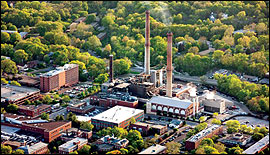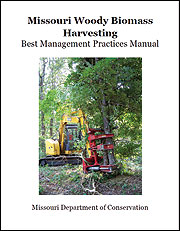In the Midwest, when people think of using woody biomass for energy, the first thought that usually comes to mind is burning wood in a fireplace or wood stove. But the passage of the Energy Independence and Security Act of 2007 combined with the fact that one-third of Missouri is forested has tremendously increased interest in using this natural resource on a much larger scale. This guide defines woody biomass and describes how it can be used for energy, its various sources, and how it is harvested from the forest. This guide also highlights voluntary environmental safeguards to ensure woody biomass is sustainably harvested and provides insight gained from surveys seeking to understand landowner interest in harvesting it.
Woody biomass defined
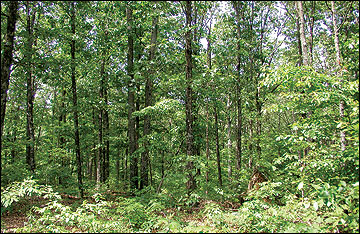
By strict definition, woody biomass consists of the roots, wood, bark and leaves of living and dead woody shrubs and trees. When harvesting woody biomass for producing energy, however, it is practical to consider only the aboveground portion (Figure 1).
Woody biomass is measured in tons, and a typical acre of Missouri forest contains just over 70 tons. But not all of this biomass is harvested at any one time. Good forest managers remove only about 25 percent, or 18 tons, at one time for traditional forest products, such as lumber and flooring. Half of the biomass is left standing as an intact forest to provide habitat for wildlife and to grow more wood for future harvests. The remaining 25 percent lies in the tops of the harvested trees and in small-diameter trees of poor form or health left in the forest because they have no commercial value. Before the increased interest in woody biomass, the only use for this last 25 percent has been firewood, if it was harvested at all.
How woody biomass is used for energy
Today, combustion is the most common way woody biomass is used to produce energy. In fireplaces and wood stoves, the energy produced is thermal energy. In utility companies, the energy produced is also thermal, but that thermal energy is used to produce steam that then drives a generator to produce electricity. Burning wood to produce steam to turn a generator uses less than one-third of the energy released in the combustion process; the rest goes up the smoke stack. Some energy facilities, such as that of the University of Missouri’s Columbia campus, are what are called combined heat and power (CHP) plants. After the steam turns a generator to produce electricity, the waste steam is then distributed via pipes to heat and cool campus buildings. Recently, MU installed a biomass boiler that supplies 25 percent of the total electrical and thermal energy required by the campus. (See MU energy plant sidebar.) The Missouri University of Science and Technology in Rolla and Northwest Missouri State University in Maryville also have used wood chips in their energy facilities to supply thermal energy to their campus buildings.
Other thermochemical processes include gasification, in which biomass is turned directly into what is called syngas, short for synthesis gas; and pyrolysis, in which biomass is converted into bio-oil, which is similar to home heating oil. Fermentation is the biological process of using microorganisms and enzymes to convert biomass into liquid transportation fuels, such as ethanol. This conversion is a relatively easy process if the source of biomass is corn; not so easy if the biomass is wood. Although promising, these more advanced wood-to-energy processes have yet to reach commercial scale.
Sources of woody biomass
Woody biomass can come from many sources, some of which are more readily and consistently available than others. Woody biomass in a standing forest is just one of several sources available to an energy facility. The more common sources and their relative availability are described below. The actual supply breakdown to a specific facility will depend on local conditions, such as the distance between the biomass source and the mill, and the cost to produce one biomass source versus another biomass source.
Mill waste

Sawmill residues (Figure 2) can be used to create electrical and thermal energy. However, in Missouri, about 93 percent of this material goes into other value-added products, such as charcoal, landscape mulch and wood pellets for home heating stoves. In the free market system, price will determine where this material goes.
Debris from natural disasters
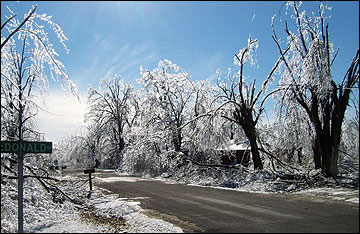
Woody biomass can also be generated from trees damaged or destroyed by natural disasters. The most common natural disasters in Missouri are ice and wind storms (Figure 3). Such disasters can generate large amounts of woody biomass, but this supply is unpredictable. So although energy facilities will use this material when available, they do not base business decisions on this source.
Short-rotation plantations
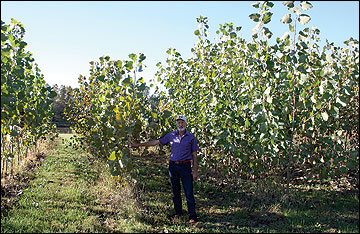
Fast-growing species such as cottonwood or willow can be grown in what are called short-rotation plantations (Figure 4). Woody biomass can be harvested every three to five years, after which the stumps generate new shoots. This cycle can be repeated several times before the site needs to be replanted. But these plantations will not be grown on land more suitable for higher-value agronomic crops like corn or soybeans. Short-rotation wood energy crops will be limited to marginal fields and pastures. In addition, experts estimate it will take 10 to 15 years to develop supply chains capable of delivering this form of woody biomass to an energy facility on a reliable basis.
Logging residues and small-diameter trees
Branches, tops, stumps and other woody debris from commercial harvesting operations are often left at the harvest site (Figure 5). In addition, trees of small-diameter, poor form or ill health are left in the woods because no markets currently exist for them. Those trees, like weeds in a garden, compete with more desirable plants for sunlight, water and nutrients. This overcrowding results in trees of lower vigor that are more susceptible to attack from insects and disease. The excess wood also places the entire forest at risk of catastrophic fire.
Of all the sources, logging residues and small-diameter trees are the most readily available forms of woody biomass.
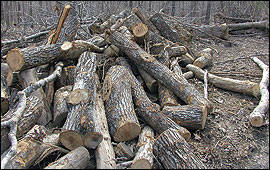
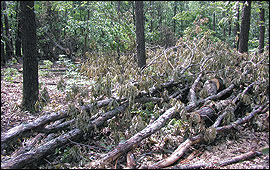
Harvesting systems
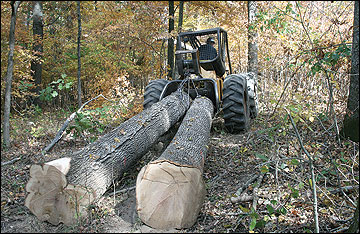
Traditionally, trees to be harvested are felled by a person with a chain saw and cut by the sawyer into logs. The logs are then skidded, or transported, to the edge of the forest (Figure 6) where they are loaded onto a log truck for delivery to the sawmill.
When woody biomass is harvested, the entire tree is brought to the forest edge where the trees of commercial value and size are placed in one pile and processed, and nonsalable trees are placed in another pile to be chipped and placed in semitrailers for transport to the energy facility (Figure 7). The simultaneous removal of woody biomass and solid hardwood products is known as a one-pass or integrated harvest.
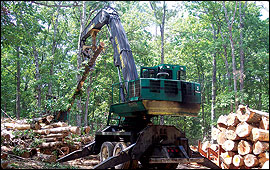
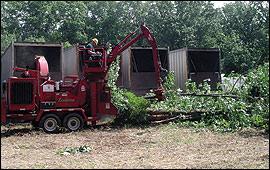
Most logging businesses favor one-pass harvesting because, other than adding a chipper, they have to make few, if any, modifications to the way they currently harvest trees. Moreover, landowners and foresters prefer this method because it is lighter on the land and thus reduces the potential for soil compaction and erosion.
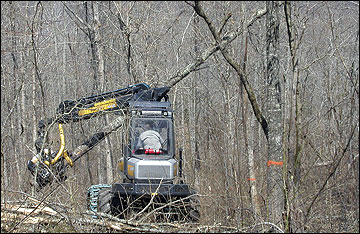
Highly mechanized pieces of harvesting equipment are now being used in Missouri’s forests (Figure 8). They are safer and more efficient for removing large amounts of wood when harvesting biomass along with more valuable timber. Cost-effectiveness of using this equipment remains a challenge, though, because of high capital and operating costs as well as the higher transportation costs of moving bigger machinery from forest to forest; the limited amount of material per operation for biomass markets specifically; and the relatively low value of biomass. These costs make the size of the forest tract being harvested and the amount of biomass available per acre important factors in determining the economic feasibility of harvesting woody biomass.
Benefits of using woody biomass
In addition to being a sustainable, renewable source for energy and biofuels, properly managed forests are healthier and grow more wood than unattended forests. Like plants in a weeded garden, the trees remaining after a properly executed harvest grow faster and bigger, removing more carbon dioxide from the atmosphere and placing it into long-lived carbon pools. Vigorous, healthy trees are also better able to resist attack from insects and disease. With less wood in the forest, the risk of a catastrophic wildfire is reduced. Improving the vigor and health of the remaining trees also means more food for wildlife in the form of both hard mast (acorns and nuts) and soft mast (berries). Finally, removing the small-diameter trees allows for more light to reach the forest floor to help regenerate the forest.

Forest landowners and rural communities can benefit, too — economically. A properly executed harvest in which woody biomass is removed not only generates modest revenue, but it actually saves the landowner money. MU researchers have shown an average of 15 green tons of woody biomass can be sustainably harvested from a typical acre of Missouri forest (Figure 9). Revenue generated from the sale of this material can range from $1 to $3 per ton, or $15 to $45 per acre. Currently, biomass can only be sold in conjunction with commercial sawtimber, and if this material is not removed, the landowner must pay $100 to $150 per acre to have the unwanted trees killed on the stump to give future crop trees room to grow. The results of harvesting biomass along with salable trees are more money in the landowner’s pocket, healthy and vigorous trees better suited to resist attack from insects and disease, and a forest with a higher value for future generations.
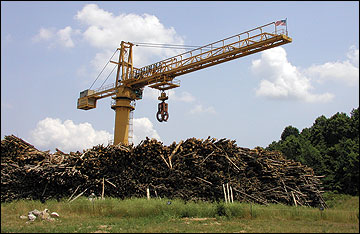
Many of Missouri’s rural communities need additional markets for their timber to help offset downturns in commercial sawtimber prices. Using logging residues and small-diameter trees, building processing facilities, and marketing the resulting products can bolster local economies (Figure 10). In addition, dollars that once left the region to buy energy outside Missouri have the potential to stay in the region by purchasing locally produced bioenergy.
Addressing environmental concerns
Harvesting woody biomass removes more woody material from a forest than a common timber harvest does. Removal of this additional woody biomass could result in soil compaction and adverse effects on future forest productivity, water quality, wildlife habitat and other environmental influences tied to forest sustainability. To ensure future forest sustainability, the Missouri Department of Conservation, in conjunction with natural resource professionals and stakeholder groups from across the state, developed a manual of best management practices (BMPs) to guide forest owners and loggers on harvesting biomass using sustainable management and harvesting techniques. (See Highlights sidebar.)
Landowner interest
In 2011, MU Department of Forestry researchers conducted surveys to better understand Missouri landowners’ motivations for owning woodlands and to gauge their potential interest in harvesting woody materials from their woodlands for energy production (Table 1). The survey results suggest that although Missouri’s woodland owners are interested in harvesting woody biomass for renewable energy, current market prices may not provide sufficient incentive. While higher woody biomass prices may increase a landowner’s willingness to harvest woody biomass, sawtimber prices were the predominant drivers for harvesting. The surveys also indicated that public incentives do not increase landowners’ willingness to harvest.
Table 1. Summary of results of the “Woodland Management and Bioenergy” study conducted among private woodland owners in Missouri.
| Topic | Responses | Percentage |
|---|---|---|
| Woodland ownership | 20 to 49 acres of woodlands | 32 percent |
| 50 to 99 acres of woodlands | 22percent | |
| 100 to 499 acres of woodlands | 26 percent | |
| Missouri family woodland owners can be categorized into four main groups | Woodland enthusiasts Main priority for owning woodlands was for privacy, protection of aesthetics and leaving behind a legacy. They were also in agreement with positive bioenergy statements. | 31 percent |
| Woodland retreat landowners Main priority for owning woodlands was for privacy. They were also in agreement with positive bioenergy statements. | 27 percent | |
| Woodland preservationists Main priority for owning woodlands was for protection of aesthetics and privacy. They neither agreed nor disagreed with positive bioenergy statements nor how woody biomass harvests affects the environment. | 24 percent | |
| Apathetic woodland owners Overall these landowners had no main priority for owning their woodlands. They found protection of aesthetics and leaving behind a legacy moderately important, and were in agreement with the positive bioenergy statements. | 20 percent | |
| Top three reasons for owning woodland in Missouri | Land has been in the family for generations | |
| Enjoyment of beauty or scenery | ||
| Privacy | ||
| Forest management | Landowners who have a forest management plan | 8 percent |
| Landowners who have harvested timber since acquiring their woodlands | 91 percent | |
| Average price landowners are willing to consider for timber harvest | Would harvest for $100 to $300 per acre | 28 percent |
| Would harvest for a higher price | 22 percent | |
| Would not harvest, regardless of price | 37 percent | |
| Views toward woody biomass as a renewable energy | Overall support for bioenergy Sees potential of woody biomass harvests to impact the environment | |
| Top five statements landowners agreed with about the use of woody biomass to produce bioenergy: | Waste wood from forest harvests should be used for energy/fuel generation. | |
| Harvesting woody biomass for energy/fuel is likely to benefit local economies. | ||
| I support harvesting woody biomass for energy. | ||
| Forest health is likely to be improved by harvesting woody biomass. | ||
| Woody biomass is a viable alternative to fossil energy (e.g., coal, oil, gasoline, diesel). | ||
| Average price landowners are willing to consider for harvesting woody biomass | Landowners indicated between $25 to $75 per acre | 32 percent |
| Would harvest for a higher price | 20 percent | |
| Would not harvest, regardless of price | 33 percent | |
| Note: This results summary is from the University of Missouri master’s thesis of Marissa “Jo” Daniel, “Social Availability of Woody Biomass for Renewable Energy: Missouri Non-Industrial Private Forest Landowners’ Perspective,“ University of Missouri, 2012. | ||
For more information
If you are interested in learning more about wood energy, visit eXtension’s Wood Energy website. To find out if harvesting woody biomass from your forest is a possibility, contact your local professional forester.
